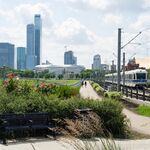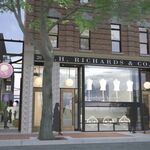archited
Senior Member
BRT has been an unmitigated failure in Los Angeles and other large cities.
It's actually been a huge success in many South American cities, including cities fairly large, such as Bogota (Colombia), Curitiba (Brazil). It doesn't do well in megacities, but anywhere in the range from 500k inhabitants to 2million, it does the job fairly well, as long as it's well designed.BRT has been an unmitigated failure in Los Angeles and other large cities.
I think as far as on-demand autonomous buses go, it would definitely replace most suburban bus routes. The LRT stops would become transfer points for those on-demand vehicles while trains itself become automated. Main trunk bus routes would become fixed automated routes.@Daveography you misread what I was trying to get across -- if you read the planning article you will see that the the BRT was instituted after "normal" bus service and that ridership was already high for the factors that I mentioned. I wasn't arguing numbers against bus ridership, simply against the "miracle" of BRT ridership. I lived in Ottawa for two years while attending Carleton University and my girl-friend at the time always pleaded with me to pick her up so that she didn't have to take the bus. I now work closely with Doug Cardinal whose office is in Ottawa and his staff continually complain about bus service (both yours and my experiences are anecdotal so they kind of erase each other out from an argument standpoint). Many bus routes in Los Angeles are packed to over capacity and for one+ weeks when my car was out of service and I had to take the bus (after a few miscalculations) from where I lived to where I worked as a consultant I had to enjoy the horror of sweaty, crowded, stinky bus rides that could not be counted on for destination accuracy time-wise, typically a 3+ hour ride one way. The indelible imprint of that experience has left a memory-tissue scar that will never go away. These were not rickety old buses (although some were artlessly covered in graffiti); the last leg was BRT and these exacerbated the inconveniences. Finally, I highly doubt that Edmonton could solve any convenience issues with BRT. A better solution would be on-call automated buses that are now available in several cities and are beginning to crop up in many civic jurisdictions.
@Daveography you misread what I was trying to get across -- if you read the planning article you will see that the the BRT was instituted after "normal" bus service and that ridership was already high for the factors that I mentioned. I wasn't arguing numbers against bus ridership, simply against the "miracle" of BRT ridership. I lived in Ottawa for two years while attending Carleton University and my girl-friend at the time always pleaded with me to pick her up so that she didn't have to take the bus. I now work closely with Doug Cardinal whose office is in Ottawa and his staff continually complain about bus service (both yours and my experiences are anecdotal so they kind of erase each other out from an argument standpoint). Many bus routes in Los Angeles are packed to over capacity and for one+ weeks when my car was out of service and I had to take the bus (after a few miscalculations) from where I lived to where I worked as a consultant I had to enjoy the horror of sweaty, crowded, stinky bus rides that could not be counted on for destination accuracy time-wise, typically a 3+ hour ride one way. The indelible imprint of that experience has left a memory-tissue scar that will never go away. These were not rickety old buses (although some were artlessly covered in graffiti); the last leg was BRT and these exacerbated the inconveniences. Finally, I highly doubt that Edmonton could solve any convenience issues with BRT. A better solution would be on-call automated buses that are now available in several cities and are beginning to crop up in many civic jurisdictions.
From the LRT Network Expansion and Renewal Update going to Executive Committee on November 9.The mass transit study affirmed the demand for transit along the Whyte Avenue corridor and further determined the service could also be accommodated by non-LRT technologies. Administration will return to council in 2021 with recommended next steps.
The LRT expansion projects approved by City Council will necessitate a substantial growth in the light rail vehicle fleet in the upcoming years. This, combined with the need to replace 37 of the oldest fleet of trains that are already operating well past their design life, results in the need to procure a considerable number of light rail vehicles in the near term. Continuing to operate and maintain the older fleet of trains beyond a 5 year horizon will pose a risk to providing in-service LRVs to meet ridership demands.
As many as 142 new high-floor vehicles may be required to support the extension to the Capital Line south and Metroline north, to provide the required service frequency on the existing Capital and Metro lines, and to address the upcoming fleet replacements. This could result in a funding requirement of over $900 million in the short-to-medium term. Administration is having conversations with the City of Calgary about possible joint procurement of light rail vehicles and continues to explore alternatives for long-term funding with potential partners.




